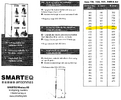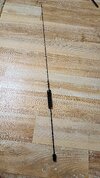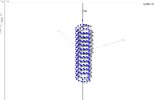Hello to all,
I tried to model this mobile antenna https://www.wimo.com/en/62006 with the 1123 antenna base in EZNEC, shortened according this table to 404MHz.


It is designed to be a colinear stacked 1/4λ+1/2λ antenna. My focus was to model the geometry as exact as possible.
But I have two questions:
1. As I have modeled the helix quite exact, will EZNEC then automatically calculate the inductivity / capacity in its modeling? The value for the helix would be 0.519µH and 1.168pF.
2. How can I model a car roof in EZNEC?
Some more background information: I want to use this antenna for DAB+ reception (174-230MHz) and want to know how it behaves as a colinear stacked 1/8λ+1/4λ antenna for 202MHz.
Some help / advice is appreciated. Thanks in advance.
Best regards
Oliver
I tried to model this mobile antenna https://www.wimo.com/en/62006 with the 1123 antenna base in EZNEC, shortened according this table to 404MHz.


It is designed to be a colinear stacked 1/4λ+1/2λ antenna. My focus was to model the geometry as exact as possible.
But I have two questions:
1. As I have modeled the helix quite exact, will EZNEC then automatically calculate the inductivity / capacity in its modeling? The value for the helix would be 0.519µH and 1.168pF.
2. How can I model a car roof in EZNEC?
Some more background information: I want to use this antenna for DAB+ reception (174-230MHz) and want to know how it behaves as a colinear stacked 1/8λ+1/4λ antenna for 202MHz.
Some help / advice is appreciated. Thanks in advance.
Best regards
Oliver


